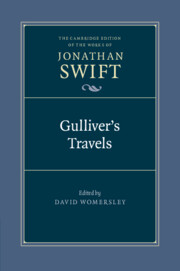Book contents
- Frontmatter
- Contents
- List of Illustrations
- General Editors’ Preface
- Acknowledgements
- Chronology of Swift’s Life
- Chronology of Gulliver’s Travels
- List of Abbreviations
- Introduction
- Gulliver’s Travels
- A Letter From Capt. Gulliver, to His Cousin Sympson
- The Publisher to the Reader
- The Contents
- Part I
- Part II
- Part III
- Part IV
- Long Notes
- Appendices
- Textual Introduction
- Select Bibliography
- Index
A - The Frontispiece Portraits of Lemuel Gulliver
Published online by Cambridge University Press: 02 September 2021
- Frontmatter
- Contents
- List of Illustrations
- General Editors’ Preface
- Acknowledgements
- Chronology of Swift’s Life
- Chronology of Gulliver’s Travels
- List of Abbreviations
- Introduction
- Gulliver’s Travels
- A Letter From Capt. Gulliver, to His Cousin Sympson
- The Publisher to the Reader
- The Contents
- Part I
- Part II
- Part III
- Part IV
- Long Notes
- Appendices
- Textual Introduction
- Select Bibliography
- Index
Summary
The portraits of Lemuel Gulliver which serve as the frontispiece to early editions of Gulliver's Travels exist in a number of forms and states, and the variations between them have been plausibly related to Swift's satiric strategies for the book. Early copies of the 1726 Benjamin Motte editions normally include the first state of the portrait (fig. 9), in which the oval frame of the portrait includes no text, and in which the identity, residence and age of the subject are given in the tablet below. Intriguingly, the age specified for Gulliver is not the age which can be inferred from the internal chronology of the work, but is instead that of Swift himself when GT was published.
Later copies of Motte's 1726 editions normally have the second state of the portrait (fig. 10), in which the information inscribed on the tablet in the first state has been moved to the oval frame, and the tablet bears two lines from Persius's second satire, celebrating the human virtues which cannot be purchased by money:
Compositum jus, fasque animi, sanctosque recessus Mentis, & incoctum generoso pectus honesto.
A third state exists, virtually identical with the second, and struck from the same plate, but slightly retouched and printed on paper with horizontal rather than vertical chain lines; an example is to be found in the celebrated ‘Ham House’ copy in theWren Library, Trinity College, Cambridge. These portraits were designed by John Sturt (1658–1730), who enjoyed a previous connection with Swift, having also designed a frontispiece for the fifth edition of A Tale of a Tub (1710). The engraver went by the name of Sheppard.
Different portraits were engraved for George Faulkner's 1735 editions of Gulliver's Travels (printed as volume three of the four-volume octavo and duodecimo editions of Swift's Works). In these later portraits the information about Gulliver's age and place of residence which had been included in the portraits prepared forMotte's editions was deleted. So, too, was the epigraph from Persius. It was replacedwith the Horatian tag ‘SplendideMendax’. For the octavo edition (see above, p. 2), the portrait of Gulliver bears a striking resemblance to the portrait of Swift himself (fig. 11).
- Type
- Chapter
- Information
- Gulliver's Travels , pp. 567 - 572Publisher: Cambridge University PressPrint publication year: 2012

